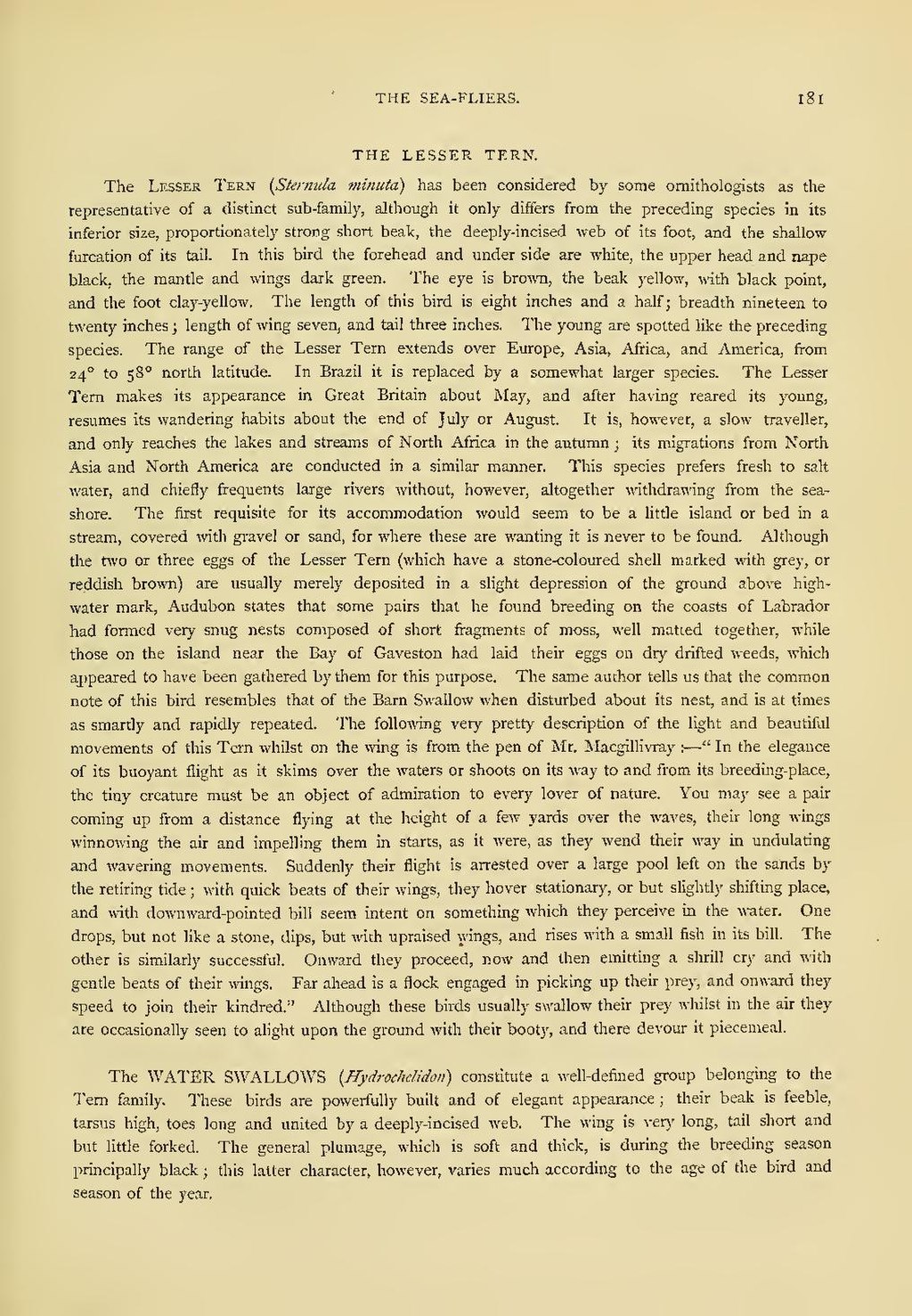THE LESSER TERN.
The Lesser Tern (Sternula minuta) has been considered by some ornithologists as the representative of a distinct sub-family, although it only differs from the preceding species in its inferior size, proportionately strong short beak, the deeply-incised web of its foot, and the shallow furcation of its tail. In this bird the forehead and under side are white, the upper head and nape black, the mantle and wings dark green. The eye is brown, the beak yellow, with black point, and the foot clay-yellow. The length of this bird is eight inches and a half; breadth nineteen to twenty inches; length of wing seven, and tail three inches. The young are spotted like the preceding species. The range of the Lesser Tern extends over Europe, Asia, Africa, and America, from 24° to 58° north latitude. In Brazil it is replaced by a somewhat larger species. The Lesser Tern makes its appearance in Great Britain about May, and after having reared its young, resumes its wandering habits about the end of July or August. It is, however, a slow traveller, and only reaches the lakes and streams of North Africa in the autumn; its migrations from North Asia and North America are conducted in a similar manner. This species prefers fresh to salt water, and chiefly frequents large rivers without, however, altogether withdrawing from the sea-*shore. The first requisite for its accommodation would seem to be a little island or bed in a stream, covered with gravel or sand, for where these are wanting it is never to be found. Although the two or three eggs of the Lesser Tern (which have a stone-coloured shell marked with grey, or reddish brown) are usually merely deposited in a slight depression of the ground above high-water mark, Audubon states that some pairs that he found breeding on the coasts of Labrador had formed very snug nests composed of short fragments of moss, well matted together, while those on the island near the Bay of Gaveston had laid their eggs on dry drifted weeds, which appeared to have been gathered by them for this purpose. The same author tells us that the common note of this bird resembles that of the Barn Swallow when disturbed about its nest, and is at times as smartly and rapidly repeated. The following very pretty description of the light and beautiful movements of this Tern whilst on the wing is from the pen of Mr. Macgillivray:—"In the elegance of its buoyant flight as it skims over the waters or shoots on its way to and from its breeding-place, the tiny creature must be an object of admiration to every lover of nature. You may see a pair coming up from a distance flying at the height of a few yards over the waves, their long wings winnowing the air and impelling them in starts, as it were, as they wend their way in undulating and wavering movements. Suddenly their flight is arrested over a large pool left on the sands by the retiring tide; with quick beats of their wings, they hover stationary, or but slightly shifting place, and with downward-pointed bill seem intent on something which they perceive in the water. One drops, but not like a stone, dips, but with upraised wings, and rises with a small fish in its bill. The other is similarly successful. Onward they proceed, now and then emitting a shrill cry and with gentle beats of their wings. Far ahead is a flock engaged in picking up their prey, and onward they speed to join their kindred." Although these birds usually swallow their prey whilst in the air they are occasionally seen to alight upon the ground with their booty, and there devour it piecemeal.
The WATER SWALLOWS (Hydrochelidon) constitute a well-defined group belonging to the Tern family. These birds are powerfully built and of elegant appearance; their beak is feeble, tarsus high, toes long and united by a deeply-incised web. The wing is very long, tail short and but little forked. The general plumage, which is soft and thick, is during the breeding season principally black; this latter character, however, varies much according to the age of the bird and season of the year.
